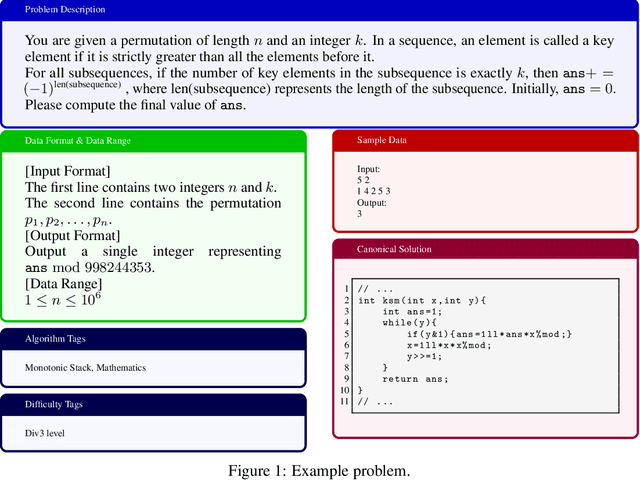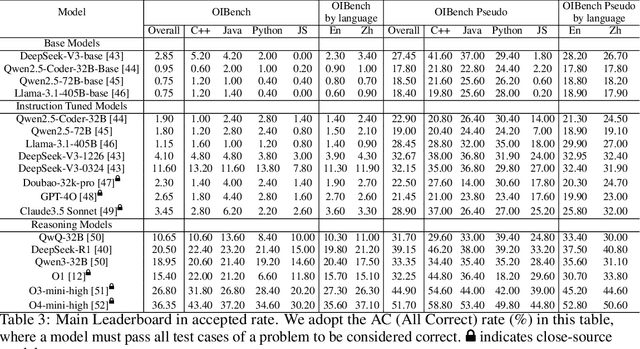Jun Xu
Nankai University
Thinker: Training LLMs in Hierarchical Thinking for Deep Search via Multi-Turn Interaction
Nov 14, 2025Abstract:Efficient retrieval of external knowledge bases and web pages is crucial for enhancing the reasoning abilities of LLMs. Previous works on training LLMs to leverage external retrievers for solving complex problems have predominantly employed end-to-end reinforcement learning. However, these approaches neglect supervision over the reasoning process, making it difficult to guarantee logical coherence and rigor. To address these limitations, we propose Thinker, a hierarchical thinking model for deep search through multi-turn interaction, making the reasoning process supervisable and verifiable. It decomposes complex problems into independently solvable sub-problems, each dually represented in both natural language and an equivalent logical function to support knowledge base and web searches. Concurrently, dependencies between sub-problems are passed as parameters via these logical functions, enhancing the logical coherence of the problem-solving process. To avoid unnecessary external searches, we perform knowledge boundary determination to check if a sub-problem is within the LLM's intrinsic knowledge, allowing it to answer directly. Experimental results indicate that with as few as several hundred training samples, the performance of Thinker is competitive with established baselines. Furthermore, when scaled to the full training set, Thinker significantly outperforms these methods across various datasets and model sizes. The source code is available at https://github.com/OpenSPG/KAG-Thinker.
LLaDA-Rec: Discrete Diffusion for Parallel Semantic ID Generation in Generative Recommendation
Nov 09, 2025Abstract:Generative recommendation represents each item as a semantic ID, i.e., a sequence of discrete tokens, and generates the next item through autoregressive decoding. While effective, existing autoregressive models face two intrinsic limitations: (1) unidirectional constraints, where causal attention restricts each token to attend only to its predecessors, hindering global semantic modeling; and (2) error accumulation, where the fixed left-to-right generation order causes prediction errors in early tokens to propagate to the predictions of subsequent token. To address these issues, we propose LLaDA-Rec, a discrete diffusion framework that reformulates recommendation as parallel semantic ID generation. By combining bidirectional attention with the adaptive generation order, the approach models inter-item and intra-item dependencies more effectively and alleviates error accumulation. Specifically, our approach comprises three key designs: (1) a parallel tokenization scheme that produces semantic IDs for bidirectional modeling, addressing the mismatch between residual quantization and bidirectional architectures; (2) two masking mechanisms at the user-history and next-item levels to capture both inter-item sequential dependencies and intra-item semantic relationships; and (3) an adapted beam search strategy for adaptive-order discrete diffusion decoding, resolving the incompatibility of standard beam search with diffusion-based generation. Experiments on three real-world datasets show that LLaDA-Rec consistently outperforms both ID-based and state-of-the-art generative recommenders, establishing discrete diffusion as a new paradigm for generative recommendation.
PrLM: Learning Explicit Reasoning for Personalized RAG via Contrastive Reward Optimization
Aug 10, 2025Abstract:Personalized retrieval-augmented generation (RAG) aims to produce user-tailored responses by incorporating retrieved user profiles alongside the input query. Existing methods primarily focus on improving retrieval and rely on large language models (LLMs) to implicitly integrate the retrieved context with the query. However, such models are often sensitive to retrieval quality and may generate responses that are misaligned with user preferences. To address this limitation, we propose PrLM, a reinforcement learning framework that trains LLMs to explicitly reason over retrieved user profiles. Guided by a contrastively trained personalization reward model, PrLM effectively learns from user responses without requiring annotated reasoning paths. Experiments on three personalized text generation datasets show that PrLM outperforms existing methods and remains robust across varying numbers of retrieved profiles and different retrievers.
KuaiLive: A Real-time Interactive Dataset for Live Streaming Recommendation
Aug 07, 2025



Abstract:Live streaming platforms have become a dominant form of online content consumption, offering dynamically evolving content, real-time interactions, and highly engaging user experiences. These unique characteristics introduce new challenges that differentiate live streaming recommendation from traditional recommendation settings and have garnered increasing attention from industry in recent years. However, research progress in academia has been hindered by the lack of publicly available datasets that accurately reflect the dynamic nature of live streaming environments. To address this gap, we introduce KuaiLive, the first real-time, interactive dataset collected from Kuaishou, a leading live streaming platform in China with over 400 million daily active users. The dataset records the interaction logs of 23,772 users and 452,621 streamers over a 21-day period. Compared to existing datasets, KuaiLive offers several advantages: it includes precise live room start and end timestamps, multiple types of real-time user interactions (click, comment, like, gift), and rich side information features for both users and streamers. These features enable more realistic simulation of dynamic candidate items and better modeling of user and streamer behaviors. We conduct a thorough analysis of KuaiLive from multiple perspectives and evaluate several representative recommendation methods on it, establishing a strong benchmark for future research. KuaiLive can support a wide range of tasks in the live streaming domain, such as top-K recommendation, click-through rate prediction, watch time prediction, and gift price prediction. Moreover, its fine-grained behavioral data also enables research on multi-behavior modeling, multi-task learning, and fairness-aware recommendation. The dataset and related resources are publicly available at https://imgkkk574.github.io/KuaiLive.
Bridging Search and Recommendation through Latent Cross Reasoning
Aug 06, 2025Abstract:Search and recommendation (S&R) are fundamental components of modern online platforms, yet effectively leveraging search behaviors to improve recommendation remains a challenging problem. User search histories often contain noisy or irrelevant signals that can even degrade recommendation performance, while existing approaches typically encode S&R histories either jointly or separately without explicitly identifying which search behaviors are truly useful. Inspired by the human decision-making process, where one first identifies recommendation intent and then reasons about relevant evidence, we design a latent cross reasoning framework that first encodes user S&R histories to capture global interests and then iteratively reasons over search behaviors to extract signals beneficial for recommendation. Contrastive learning is employed to align latent reasoning states with target items, and reinforcement learning is further introduced to directly optimize ranking performance. Extensive experiments on public benchmarks demonstrate consistent improvements over strong baselines, validating the importance of reasoning in enhancing search-aware recommendation.
Benefit from Rich: Tackling Search Interaction Sparsity in Search Enhanced Recommendation
Aug 06, 2025Abstract:In modern online platforms, search and recommendation (S&R) often coexist, offering opportunities for performance improvement through search-enhanced approaches. Existing studies show that incorporating search signals boosts recommendation performance. However, the effectiveness of these methods relies heavily on rich search interactions. They primarily benefit a small subset of users with abundant search behavior, while offering limited improvements for the majority of users who exhibit only sparse search activity. To address the problem of sparse search data in search-enhanced recommendation, we face two key challenges: (1) how to learn useful search features for users with sparse search interactions, and (2) how to design effective training objectives under sparse conditions. Our idea is to leverage the features of users with rich search interactions to enhance those of users with sparse search interactions. Based on this idea, we propose GSERec, a method that utilizes message passing on the User-Code Graphs to alleviate data sparsity in Search-Enhanced Recommendation. Specifically, we utilize Large Language Models (LLMs) with vector quantization to generate discrete codes, which connect similar users and thereby construct the graph. Through message passing on this graph, embeddings of users with rich search data are propagated to enhance the embeddings of users with sparse interactions. To further ensure that the message passing captures meaningful information from truly similar users, we introduce a contrastive loss to better model user similarities. The enhanced user representations are then integrated into downstream search-enhanced recommendation models. Experiments on three real-world datasets show that GSERec consistently outperforms baselines, especially for users with sparse search behaviors.
StyliTruth : Unlocking Stylized yet Truthful LLM Generation via Disentangled Steering
Aug 06, 2025Abstract:Generating stylized large language model (LLM) responses via representation editing is a promising way for fine-grained output control. However, there exists an inherent trade-off: imposing a distinctive style often degrades truthfulness. Existing representation editing methods, by naively injecting style signals, overlook this collateral impact and frequently contaminate the model's core truthfulness representations, resulting in reduced answer correctness. We term this phenomenon stylization-induced truthfulness collapse. We attribute this issue to latent coupling between style and truth directions in certain key attention heads, and propose StyliTruth, a mechanism that preserves stylization while keeping truthfulness intact. StyliTruth separates the style-relevant and truth-relevant subspaces in the model's representation space via an orthogonal deflation process. This decomposition enables independent control of style and truth in their own subspaces, minimizing interference. By designing adaptive, token-level steering vectors within each subspace, we dynamically and precisely control the generation process to maintain both stylistic fidelity and truthfulness. We validate our method on multiple styles and languages. Extensive experiments and analyses show that StyliTruth significantly reduces stylization-induced truthfulness collapse and outperforms existing inference-time intervention methods in balancing style adherence with truthfulness.
Similarity = Value? Consultation Value Assessment and Alignment for Personalized Search
Jun 17, 2025Abstract:Personalized search systems in e-commerce platforms increasingly involve user interactions with AI assistants, where users consult about products, usage scenarios, and more. Leveraging consultation to personalize search services is trending. Existing methods typically rely on semantic similarity to align historical consultations with current queries due to the absence of 'value' labels, but we observe that semantic similarity alone often fails to capture the true value of consultation for personalization. To address this, we propose a consultation value assessment framework that evaluates historical consultations from three novel perspectives: (1) Scenario Scope Value, (2) Posterior Action Value, and (3) Time Decay Value. Based on this, we introduce VAPS, a value-aware personalized search model that selectively incorporates high-value consultations through a consultation-user action interaction module and an explicit objective that aligns consultations with user actions. Experiments on both public and commercial datasets show that VAPS consistently outperforms baselines in both retrieval and ranking tasks.
OIBench: Benchmarking Strong Reasoning Models with Olympiad in Informatics
Jun 12, 2025



Abstract:As models become increasingly sophisticated, conventional algorithm benchmarks are increasingly saturated, underscoring the need for more challenging benchmarks to guide future improvements in algorithmic reasoning. This paper introduces OIBench, a high-quality, private, and challenging olympiad-level informatics dataset comprising 250 carefully curated original problems. We detail the construction methodology of the benchmark, ensuring a comprehensive assessment across various programming paradigms and complexities, and we demonstrate its contamination-resistant properties via experiments. We propose Time/Space Completion Curves for finer-grained efficiency analysis and enable direct human-model comparisons through high-level participant evaluations. Our experiments reveal that while open-source models lag behind closed-source counterparts, current SOTA models already outperform most human participants in both correctness and efficiency, while still being suboptimal compared to the canonical solutions. By releasing OIBench as a fully open-source resource (https://huggingface.co/datasets/AGI-Eval/OIBench), we hope this benchmark will contribute to advancing code reasoning capabilities for future LLMs.
NExT-Search: Rebuilding User Feedback Ecosystem for Generative AI Search
May 20, 2025Abstract:Generative AI search is reshaping information retrieval by offering end-to-end answers to complex queries, reducing users' reliance on manually browsing and summarizing multiple web pages. However, while this paradigm enhances convenience, it disrupts the feedback-driven improvement loop that has historically powered the evolution of traditional Web search. Web search can continuously improve their ranking models by collecting large-scale, fine-grained user feedback (e.g., clicks, dwell time) at the document level. In contrast, generative AI search operates through a much longer search pipeline, spanning query decomposition, document retrieval, and answer generation, yet typically receives only coarse-grained feedback on the final answer. This introduces a feedback loop disconnect, where user feedback for the final output cannot be effectively mapped back to specific system components, making it difficult to improve each intermediate stage and sustain the feedback loop. In this paper, we envision NExT-Search, a next-generation paradigm designed to reintroduce fine-grained, process-level feedback into generative AI search. NExT-Search integrates two complementary modes: User Debug Mode, which allows engaged users to intervene at key stages; and Shadow User Mode, where a personalized user agent simulates user preferences and provides AI-assisted feedback for less interactive users. Furthermore, we envision how these feedback signals can be leveraged through online adaptation, which refines current search outputs in real-time, and offline update, which aggregates interaction logs to periodically fine-tune query decomposition, retrieval, and generation models. By restoring human control over key stages of the generative AI search pipeline, we believe NExT-Search offers a promising direction for building feedback-rich AI search systems that can evolve continuously alongside human feedback.
 Add to Chrome
Add to Chrome Add to Firefox
Add to Firefox Add to Edge
Add to Edge